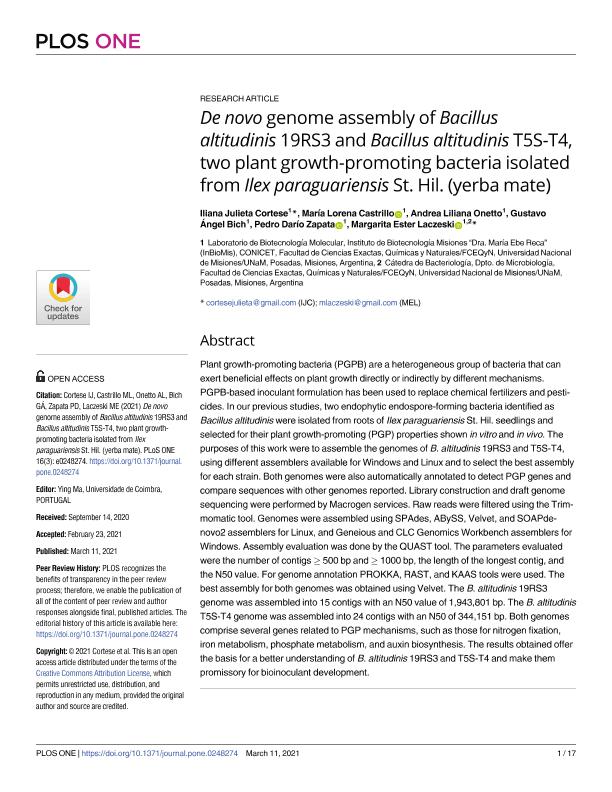Mostrar el registro sencillo del ítem
dc.contributor.author
Cortese, Iliana Julieta

dc.contributor.author
Castrillo, María Lorena

dc.contributor.author
Onetto, Andrea Liliana

dc.contributor.author
Bich, Gustavo Angel

dc.contributor.author
Zapata, Pedro Dario

dc.contributor.author
Laczeski, Margarita Ester

dc.date.available
2022-08-10T19:12:53Z
dc.date.issued
2021-03
dc.identifier.citation
Cortese, Iliana Julieta; Castrillo, María Lorena; Onetto, Andrea Liliana; Bich, Gustavo Angel; Zapata, Pedro Dario; et al.; De novo genome assembly of Bacillus altitudinis 19RS3 and Bacillus altitudinis T5S-T4, two plant growth-promoting bacteria isolated from Ilex paraguariensis St. Hil. (yerba mate); Public Library of Science; Plos One; 16; 3; 3-2021; 1-17
dc.identifier.issn
1932-6203
dc.identifier.uri
http://hdl.handle.net/11336/165070
dc.description.abstract
Plant growth-promoting bacteria (PGPB) are a heterogeneous group of bacteria that can exert beneficial effects on plant growth directly or indirectly by different mechanisms. PGPB-based inoculant formulation has been used to replace chemical fertilizers and pesticides. In our previous studies, two endophytic endospore-forming bacteria identified as Bacillus altitudinis were isolated from roots of Ilex paraguariensis St. Hil. seedlings and selected for their plant growth-promoting (PGP) properties shown in vitro and in vivo. The purposes of this work were to assemble the genomes of B. altitudinis 19RS3 and T5S-T4, using different assemblers available for Windows and Linux and to select the best assembly for each strain. Both genomes were also automatically annotated to detect PGP genes and compare sequences with other genomes reported. Library construction and draft genome sequencing were performed by Macrogen services. Raw reads were filtered using the Trimmomatic tool. Genomes were assembled using SPAdes, ABySS, Velvet, and SOAPdenovo2 assemblers for Linux, and Geneious and CLC Genomics Workbench assemblers for Windows. Assembly evaluation was done by the QUAST tool. The parameters evaluated were the number of contigs ≥ 500 bp and ≥ 1000 bp, the length of the longest contig, and the N50 value. For genome annotation PROKKA, RAST, and KAAS tools were used. The best assembly for both genomes was obtained using Velvet. The B. altitudinis 19RS3 genome was assembled into 15 contigs with an N50 value of 1,943,801 bp. The B. altitudinis T5S-T4 genome was assembled into 24 contigs with an N50 of 344,151 bp. Both genomes comprise several genes related to PGP mechanisms, such as those for nitrogen fixation, iron metabolism, phosphate metabolism, and auxin biosynthesis. The results obtained offer the basis for a better understanding of B. altitudinis 19RS3 and T5S-T4 and make them promissory for a bioinoculant development.
dc.format
application/pdf
dc.language.iso
eng
dc.publisher
Public Library of Science

dc.rights
info:eu-repo/semantics/openAccess
dc.rights.uri
https://creativecommons.org/licenses/by-nc-sa/2.5/ar/
dc.subject
GENOME ASSEMBLY
dc.subject
ILEX PARAGUARIENSIS
dc.subject
BACILLUS ALTITUDINIS
dc.subject
PLAN GROWTH PROMOTING BACTERIA
dc.subject.classification
Biología Celular, Microbiología

dc.subject.classification
Ciencias Biológicas

dc.subject.classification
CIENCIAS NATURALES Y EXACTAS

dc.title
De novo genome assembly of Bacillus altitudinis 19RS3 and Bacillus altitudinis T5S-T4, two plant growth-promoting bacteria isolated from Ilex paraguariensis St. Hil. (yerba mate)
dc.type
info:eu-repo/semantics/article
dc.type
info:ar-repo/semantics/artículo
dc.type
info:eu-repo/semantics/publishedVersion
dc.date.updated
2022-08-10T17:10:56Z
dc.journal.volume
16
dc.journal.number
3
dc.journal.pagination
1-17
dc.journal.pais
Estados Unidos

dc.journal.ciudad
San Francisco
dc.description.fil
Fil: Cortese, Iliana Julieta. Universidad Nacional de Misiones. Facultad de Ciencias Exactas Químicas y Naturales. Departamento de Bioquímica Clínica. Laboratorio de Biotecnología Molecular; Argentina. Consejo Nacional de Investigaciones Científicas y Técnicas. Centro Científico Tecnológico Conicet - Nordeste; Argentina
dc.description.fil
Fil: Castrillo, María Lorena. Consejo Nacional de Investigaciones Científicas y Técnicas. Centro Científico Tecnológico Conicet - Nordeste; Argentina. Universidad Nacional de Misiones. Facultad de Ciencias Exactas Químicas y Naturales. Departamento de Bioquímica Clínica. Laboratorio de Biotecnología Molecular; Argentina
dc.description.fil
Fil: Onetto, Andrea Liliana. Consejo Nacional de Investigaciones Científicas y Técnicas. Centro Científico Tecnológico Conicet - Nordeste; Argentina. Universidad Nacional de Misiones. Facultad de Ciencias Exactas Químicas y Naturales. Departamento de Bioquímica Clínica. Laboratorio de Biotecnología Molecular; Argentina
dc.description.fil
Fil: Bich, Gustavo Angel. Consejo Nacional de Investigaciones Científicas y Técnicas. Centro Científico Tecnológico Conicet - Nordeste; Argentina. Universidad Nacional de Misiones. Facultad de Ciencias Exactas, Químicas y Naturales. Laboratorio de Biología Molecular Aplicada; Argentina
dc.description.fil
Fil: Zapata, Pedro Dario. Consejo Nacional de Investigaciones Científicas y Técnicas. Centro Científico Tecnológico Conicet - Nordeste; Argentina. Universidad Nacional de Misiones. Facultad de Ciencias Exactas Químicas y Naturales. Departamento de Bioquímica Clínica. Laboratorio de Biotecnología Molecular; Argentina
dc.description.fil
Fil: Laczeski, Margarita Ester. Consejo Nacional de Investigaciones Científicas y Técnicas. Centro Científico Tecnológico Conicet - Nordeste; Argentina. Universidad Nacional de Misiones. Facultad de Ciencias Exactas Químicas y Naturales. Departamento de Bioquímica Clínica. Laboratorio de Biotecnología Molecular; Argentina. Universidad Nacional de Misiones. Facultad de Ciencias Exactas, Químicas y Naturales. Departamento de Microbiología; Argentina
dc.journal.title
Plos One

dc.relation.alternativeid
info:eu-repo/semantics/altIdentifier/doi/https://doi.org/10.1371/journal. pone.0248274
Archivos asociados
